Overview
-
Pros
- Gorgeous display
- Excellent build quality
- Good touchpad
- High performance
- Good battery life
-
Cons
- Keyboard layout needs improvement
- Gets warm under heavy workloads
The XPS 15 is Dell’s premium 15.6-inch
multimedia notebook offering; its hallmark feature is a Quad HD+ (3200 x
1800) screen featuring 10-point touch support. Its chassis is made of
carbon fiber and aluminum for the ideal combination of extra strength
and light weight. Other highlights include a good keyboard and touchpad,
long battery life and did we already mention the amazing screen?
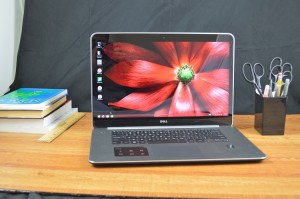 The
XPS series are halo products for Dell; they need to represent the brand
well. As a result they are designed to impress; the XPS 15 is certainly
up to the task. It’s constructed of aluminum and carbon fiber which
make this notebook both strong and light, weighing just 4.44 pounds. The
chassis is stiff and resistant to flexing as is the lid. The lid could
use a bit of extra protection as I could get ripples to appear by firmly
pressing in on the back. The rubberized palm rest and surrounding area
are pleasant to the touch and hide dust and fingerprints.
The
XPS series are halo products for Dell; they need to represent the brand
well. As a result they are designed to impress; the XPS 15 is certainly
up to the task. It’s constructed of aluminum and carbon fiber which
make this notebook both strong and light, weighing just 4.44 pounds. The
chassis is stiff and resistant to flexing as is the lid. The lid could
use a bit of extra protection as I could get ripples to appear by firmly
pressing in on the back. The rubberized palm rest and surrounding area
are pleasant to the touch and hide dust and fingerprints.
Design-wise the XPS 15 is actually scaled back; there are no
outrageous curves or other lines. Instead it looks clean and modern with
rounded but not overly rounded edges. There are smart details like the
beveled edge on the aluminum surrounding the chassis and lid. The carbon
fiber weave on the bottom of the chassis looks great in sunlight. 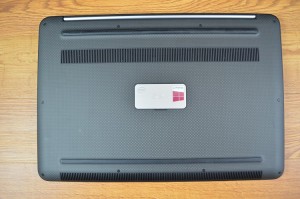 The overall impression the XPS 15 gives is that no shortcuts were made; this is a premium product through and through.
The overall impression the XPS 15 gives is that no shortcuts were made; this is a premium product through and through.
If there’s one design feature that the XPS 15 lacks, it is the ability for users to make simple upgrades. The Torx screws on the bottom of the chassis must be removed to access the innards; and while it’s possible to do this it’s also clear that DIY upgrades are not something Dell intends for users to do (otherwise it’d be easier).
Input and Output Ports
Despite being ultra-thin, the XPS 15 has a large enough chassis to accommodate four USB ports plus HDMI and mini-DisplayPort. All picture descriptions are left to right.
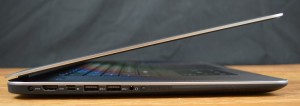
Left: AC power jack, HDMI, mini-DisplayPort, 2x USB 3.0, combination headphone/microphone jack, battery status button, battery status LEDs
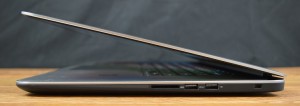
Right: 3-in-1 media card reader, USB 3.0, USB 2.0, Noble lock slot
Screen and Speakers
The XPS 15′s distinguishing feature is its remarkable Quad HD+ (3200 x 1800) display. It’s exceptionally bright and colorful; other notebooks next to the XPS 15 just look dull by comparison. This display is 10-point touch enabled; surface contact with a finger is all that’s necessary to register touch input. The display hinge is stiff enough to prevent excessive wobbling. This display’s surface is actually Corning Gorilla Glass; it has a slick feel and cleans easily. The downside of the glass surface is it acts as a mirror and creates reflections; this can be distracting in well-lit areas. Another important quality of this display is its unlimited viewing angles; look at the display from any angle you like and the picture remains more or less the same.
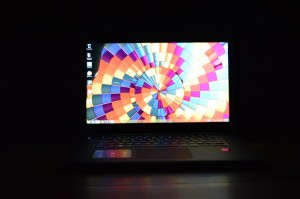
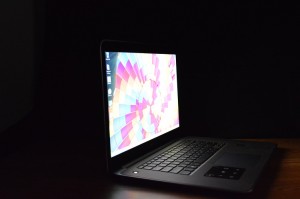
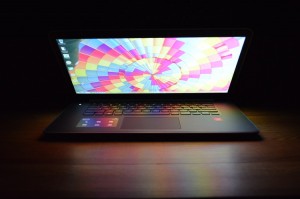
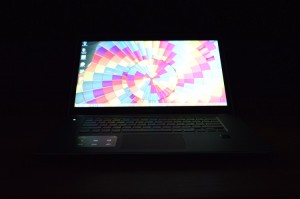
To put the 3200 x 1800 resolution in perspective, a 1080p display has just 36% of the pixels. This ultra-high resolution gives the display a very liquid look since the individual pixels are invisible. This resolution is excellent for media-related work especially photo editing, graphic design and CAD software. Dell has the text scaling set in Windows so everything more or less looks like it does on a 1080p display. Without this scaling, the text is about one-third the size and simply too small to read.
The stereo speakers are integrated into the chassis. They get surprisingly loud and have noticeable bass. The sound is somewhat muffled but certainly suffices for general listening. The headphone jack on the left side of the chassis is static-free.
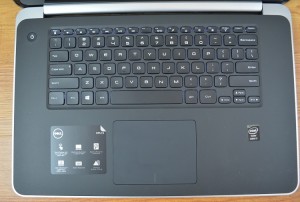 Keyboard and Touchpad
Keyboard and Touchpad
The XPS 15 features a full-size backlit keyboard with Chiclet style keys. It has very good tactile feedback thanks to its ample key travel and flex-free design. The audible feedback is pleasant as well. The actuation pressure is just right; resting fingers on the keys won’t cause them to press down unintentionally. The only real issue with this keyboard is the layout; there appears to be plenty of room to allocate dedicated home, end, pgup and pgdn keys yet they’re integrated as secondary functions into the arrow keys. The Fn key must be pressed in conjunction to use them; this is annoying and for avid text editors like myself, detrimental to productivity.
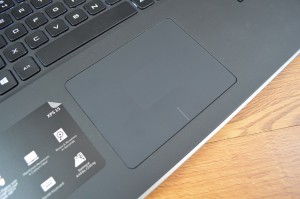 The
oversized touchpad is centered in the chassis. This is a clickpad;
press down anywhere to produce a click. Dell is one of a select few
makers that has a good clickpad implementation. Clicks take uniform
effort regardless where on the clickpad they’re made and the clickpad
surface itself is securely seated, meaning there won’t be any
unintentional mouse movements when making a click. The outstanding con
with this clickpad is that the clicks are too audible; they should be as
quiet as possible.
The
oversized touchpad is centered in the chassis. This is a clickpad;
press down anywhere to produce a click. Dell is one of a select few
makers that has a good clickpad implementation. Clicks take uniform
effort regardless where on the clickpad they’re made and the clickpad
surface itself is securely seated, meaning there won’t be any
unintentional mouse movements when making a click. The outstanding con
with this clickpad is that the clicks are too audible; they should be as
quiet as possible.
Build and Design
 The
XPS series are halo products for Dell; they need to represent the brand
well. As a result they are designed to impress; the XPS 15 is certainly
up to the task. It’s constructed of aluminum and carbon fiber which
make this notebook both strong and light, weighing just 4.44 pounds. The
chassis is stiff and resistant to flexing as is the lid. The lid could
use a bit of extra protection as I could get ripples to appear by firmly
pressing in on the back. The rubberized palm rest and surrounding area
are pleasant to the touch and hide dust and fingerprints.
The
XPS series are halo products for Dell; they need to represent the brand
well. As a result they are designed to impress; the XPS 15 is certainly
up to the task. It’s constructed of aluminum and carbon fiber which
make this notebook both strong and light, weighing just 4.44 pounds. The
chassis is stiff and resistant to flexing as is the lid. The lid could
use a bit of extra protection as I could get ripples to appear by firmly
pressing in on the back. The rubberized palm rest and surrounding area
are pleasant to the touch and hide dust and fingerprints. The overall impression the XPS 15 gives is that no shortcuts were made; this is a premium product through and through.
The overall impression the XPS 15 gives is that no shortcuts were made; this is a premium product through and through.If there’s one design feature that the XPS 15 lacks, it is the ability for users to make simple upgrades. The Torx screws on the bottom of the chassis must be removed to access the innards; and while it’s possible to do this it’s also clear that DIY upgrades are not something Dell intends for users to do (otherwise it’d be easier).
Input and Output Ports
Despite being ultra-thin, the XPS 15 has a large enough chassis to accommodate four USB ports plus HDMI and mini-DisplayPort. All picture descriptions are left to right.

Left: AC power jack, HDMI, mini-DisplayPort, 2x USB 3.0, combination headphone/microphone jack, battery status button, battery status LEDs

Right: 3-in-1 media card reader, USB 3.0, USB 2.0, Noble lock slot
Screen and Speakers
The XPS 15′s distinguishing feature is its remarkable Quad HD+ (3200 x 1800) display. It’s exceptionally bright and colorful; other notebooks next to the XPS 15 just look dull by comparison. This display is 10-point touch enabled; surface contact with a finger is all that’s necessary to register touch input. The display hinge is stiff enough to prevent excessive wobbling. This display’s surface is actually Corning Gorilla Glass; it has a slick feel and cleans easily. The downside of the glass surface is it acts as a mirror and creates reflections; this can be distracting in well-lit areas. Another important quality of this display is its unlimited viewing angles; look at the display from any angle you like and the picture remains more or less the same.




To put the 3200 x 1800 resolution in perspective, a 1080p display has just 36% of the pixels. This ultra-high resolution gives the display a very liquid look since the individual pixels are invisible. This resolution is excellent for media-related work especially photo editing, graphic design and CAD software. Dell has the text scaling set in Windows so everything more or less looks like it does on a 1080p display. Without this scaling, the text is about one-third the size and simply too small to read.
The stereo speakers are integrated into the chassis. They get surprisingly loud and have noticeable bass. The sound is somewhat muffled but certainly suffices for general listening. The headphone jack on the left side of the chassis is static-free.
 Keyboard and Touchpad
Keyboard and TouchpadThe XPS 15 features a full-size backlit keyboard with Chiclet style keys. It has very good tactile feedback thanks to its ample key travel and flex-free design. The audible feedback is pleasant as well. The actuation pressure is just right; resting fingers on the keys won’t cause them to press down unintentionally. The only real issue with this keyboard is the layout; there appears to be plenty of room to allocate dedicated home, end, pgup and pgdn keys yet they’re integrated as secondary functions into the arrow keys. The Fn key must be pressed in conjunction to use them; this is annoying and for avid text editors like myself, detrimental to productivity.
 The
oversized touchpad is centered in the chassis. This is a clickpad;
press down anywhere to produce a click. Dell is one of a select few
makers that has a good clickpad implementation. Clicks take uniform
effort regardless where on the clickpad they’re made and the clickpad
surface itself is securely seated, meaning there won’t be any
unintentional mouse movements when making a click. The outstanding con
with this clickpad is that the clicks are too audible; they should be as
quiet as possible.
The
oversized touchpad is centered in the chassis. This is a clickpad;
press down anywhere to produce a click. Dell is one of a select few
makers that has a good clickpad implementation. Clicks take uniform
effort regardless where on the clickpad they’re made and the clickpad
surface itself is securely seated, meaning there won’t be any
unintentional mouse movements when making a click. The outstanding con
with this clickpad is that the clicks are too audible; they should be as
quiet as possible.
0 komentar:
Posting Komentar